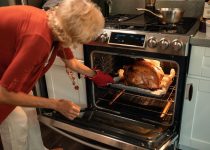How to Use a Rotisserie Oven
If you want to take your cooking skills to the next level, using a rotisserie oven is like adding a secret weapon to your culinary arsenal. Mastering the art of using a rotisserie oven can elevate your meals to a whole new level.
In this guide, you'll learn the ins and outs of how to use a rotisserie oven, from preparing the meat and setting up the rotisserie to cooking and monitoring the process. By the end, you'll be ready to serve up delicious, succulent dishes that are sure to impress.
So, let's dive in and unlock the potential of your rotisserie oven!
Key Takeaways
- Securing the meat tightly onto the rotisserie spit and using a dry rub for a flavorful crust
- Adjusting and securing the rotisserie skewer and checking the heat source for proper functioning and distribution
- Using the built-in thermometer to monitor cooking progress and adjusting positioning if uneven cooking occurs
- Carving the rested meat into slices and serving with fresh greens and a zesty vinaigrette
Rotisserie Oven Basics
To cook meat evenly and achieve a delicious, juicy flavor, you should start by securing the meat onto the rotisserie spit and then placing it into the preheated rotisserie oven. Once the meat is securely in place, it's time to focus on the spit rotation. The spit rotation is crucial for ensuring even cooking. As the rotisserie spit rotates, it allows the meat to cook evenly on all sides, resulting in a perfectly juicy and tender outcome.
When using a rotisserie oven, it's important to understand the significance of the spit rotation. This process ensures that the meat is evenly exposed to the heat, allowing it to cook uniformly. The constant rotation also helps in basting the meat with its own natural juices, enhancing the flavor and moisture retention.
Understanding the mechanics of spit rotation is key to mastering the art of using a rotisserie oven. By comprehending how the rotation contributes to even cooking, you can take your culinary skills to the next level and impress your guests with perfectly cooked, succulent meat every time.
Preparing the Meat
First, secure the meat onto the rotisserie spit, ensuring it is tightly fastened to prevent any movement during the cooking process. Properly securing the meat is essential for even cooking and to prevent it from falling off during rotation. Once the meat is secured, it's time to focus on enhancing its flavor. Seasoning tips and marinating techniques are crucial for achieving delicious, succulent results. Here are some expert tips to elevate your rotisserie cooking:
| Seasoning Tips | Marinating Techniques |
|---|---|
| 1. Use a dry rub for a flavorful crust. | 1. Marinate the meat for at least 4 hours, preferably overnight, to infuse it with flavor. |
| 2. Apply the seasoning generously, ensuring every part of the meat is covered. | 2. Consider using acidic ingredients like lemon juice or vinegar to tenderize the meat. |
| 3. Experiment with different seasoning blends to discover unique flavor profiles. | 3. Vacuum-seal the meat with the marinade for maximum flavor penetration. |
| 4. For poultry, consider using a brine to lock in moisture and add flavor. | 4. Utilize a marinade injector to distribute flavor deep into the meat. |
| 5. Don't forget to season the inside of the meat for a well-rounded flavor. | 5. Incorporate herbs, spices, and aromatics into the marinade for complexity. |
Setting Up the Rotisserie
Once the meat is securely prepared and seasoned, you can proceed to set up the rotisserie by adjusting the spit and ensuring it's properly aligned within the oven. Start by securing the rotisserie skewer in place, making sure it's centered and balanced to prevent any wobbling during the cooking process.
Next, check the heat source of your rotisserie oven. Whether it's gas, electric, or charcoal, ensure that it's functioning properly and evenly distributed to provide consistent heat for cooking. Position the heat source according to the manufacturer's guidelines to ensure optimal cooking conditions.
After securing the skewer and checking the heat source, carefully place the prepared meat onto the rotisserie skewer, ensuring that it's evenly balanced to prevent any uneven cooking. Once the meat is in place, double-check that the rotisserie is properly aligned within the oven and that there's enough clearance for the meat to rotate freely without any obstructions.
Now, you're ready to start the rotisserie and let it work its magic, slowly and evenly cooking your delicious meal to perfection.
Cooking and Monitoring
Place the meat in the rotisserie oven and use the built-in thermometer to monitor the cooking progress. Temperature control is crucial for achieving the perfect roast. Set the desired temperature according to the type of meat you're cooking. For example, poultry should reach an internal temperature of 165°F (73.9°C), while beef and pork should reach 145°F (62.8°C).
Keep an eye on the cooking time as well. Most rotisserie ovens come with a timer that allows you to set the cooking duration. However, it's essential to keep an eye on the time and check the meat's internal temperature periodically.
Throughout the cooking process, make sure the rotisserie is turning smoothly and evenly. If you notice any uneven cooking, adjust the positioning of the meat. Once the meat reaches the desired internal temperature, carefully remove it from the rotisserie and let it rest before carving.
Monitoring the temperature and cooking time will ensure that your meat is perfectly cooked and safe to eat. Mastering these elements will elevate your rotisserie cooking game to a whole new level.
Serving and Enjoying the Results
After the meat has rested, carefully carve it into slices and serve it immediately to fully enjoy the succulent and flavorful results of your rotisserie cooking efforts. Remember to savor this delicious meal that you've skillfully prepared. Here are some serving tips to elevate your dining experience:
| Serving Tips | Flavor Variations |
|---|---|
| Serve with a side of fresh greens and a zesty vinaigrette for a refreshing contrast to the rich flavors of the meat. | Experiment with different marinades such as citrus herb, spicy barbecue, or garlic and rosemary to add exciting twists to your rotisserie dishes. |
| Pair the juicy rotisserie meat with a velvety mashed potato or a buttery, roasted sweet potato for a satisfying and comforting meal. | Try seasoning the meat with international flavors like Indian tikka masala, Jamaican jerk, or Mediterranean spices for a global culinary experience. |
| For a casual gathering, consider serving the carved meat on a platter with a selection of artisan bread, cheeses, and pickles for a delightful DIY sandwich experience. | Explore the world of dry rubs, from smoky mesquite to tangy lemon pepper, to create unique and irresistible flavor profiles for your rotisserie creations. |
Frequently Asked Questions
Can I Use a Rotisserie Oven to Cook Vegetables or Other Non-Meat Items?
Yes, you can use a rotisserie oven to cook vegetables and other non-meat items. It's a healthy cooking option that offers versatile flavor infusion for non meat recipes, providing a range of flavorful and healthy dishes.
What Type of Maintenance Is Required for a Rotisserie Oven?
To maintain your rotisserie oven, regularly clean the interior and exterior, and replace any worn-out parts. Check for proper alignment of the spit rod, and troubleshoot any issues with the motor or heating elements.
Can I Use Marinades or Sauces With the Meat While It's Cooking on the Rotisserie?
You can definitely use marinades and sauces to add flavor to your meat while it's cooking on the rotisserie. Experiment with different marinade options and cooking techniques to achieve the best results.
How Do I Clean the Rotisserie Oven After Use?
After use, clean the rotisserie oven by removing and washing the spit rod, drip tray, and other removable parts with warm, soapy water. Wipe down the interior and exterior with a damp cloth. Regular maintenance ensures oven safety and optimal performance.
Are There Any Safety Precautions I Should Be Aware of When Using a Rotisserie Oven?
When using a rotisserie oven, it's crucial to follow safety measures for proper handling. Always ensure that the unit is placed on a stable surface, avoid overcrowding the spit, and use heat-resistant gloves when handling hot parts.



